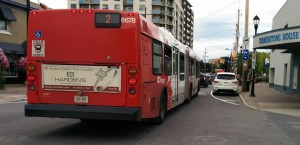Mr. One Wheel Drive is a stranger to danger. I’ve biked around Ottawa for years, going about my business without doing anything special, just getting from A to B as simply as I could. Everything went just fine, I never got honked at, took the lane when I needed to, stayed predictable and visible, and did everything else that I was told to do. But still, one day, something happened.
I bike along Somerset Street / Wellington Street West as part of my daily commute. It’s a great area with lots of shops, restaurants and bars. It’s also a major cycling route, so just about every day as I ride I pass cycling friends going the other way, or I see their bikes parked outside the bars as the partake in a tasty local brew. It’s a pretty busy stretch of road, but traffic moves slowly overall. I just keep to the side.
Recently I was chugging along, not too quickly, when a door was flung open immediately in front of me. As soon as the crack appeared in the door and it started opening I knew that the person couldn’t have any clue that I was there. It was only by braking with full force and skidding to a stop that I avoided running right into it. Amazingly, the driver got out, fiddled with her purse and got out of her car without even noticing me standing there. Had I passed a second sooner, I would have smacked right into the door.
I went back the following day to take pictures of the scene. I asked a passing cyclist to stand in as a model for the exact position where I was:
Unfortunately, because this is such a popular bike route, doorings are all too common. The Ottawa Bike Lanes Project has been documenting recent cases, and in just a three months there were seven different bike / car collisions.
It doesn’t matter how visible you make yourself, the people opening the door don’t event look. Even a deputy chief of the Ottawa police, wearing a high-viz vest, got doored.
This is a completely unacceptable. It is not long until there is a tragedy and someone loses a life or is severely injured.
The road simply isn’t wide enough. Drivers feel like cyclists are in the way. At the very least, some kind of signs are required, reminding parkers to check for cyclists before opening the doors, and notices painted on the road instructing cars to yield to bikes. Better enforcement is also needed to prosecute offenders.
To truly solve the problem, at least one lane of parking needs to be removed and the resulting space needs to be given over to cyclists, but store owners have rejected any such discussions outright. They feel like it’s already difficult to convince shoppers to come to the neighbourhood because of parking and traffic woes. Even removing a single parking spot was met with fierce resistance. They complain that they are competing with suburban malls for shoppers, and in this battle the mall wins the convenience battle.
It’s a bit of a false argument because the local stores are not in competition with the malls. They are not competing with Walmart or Loblaws. They are complementing them. The people who get into their cars and drive to Loblaws? Wellington West has already lost that battle. Less parking won’t make the difference.
People that drive into Wellington West are looking for either specialized goods or a shopping experience not available elsewhere. People come to Parma Ravioli because they make darned tootin’ good pasta, not because of the ample parking. They come to stroll from shop to shop, punctuating their afternoon with a coffee and a pastry. If anything, making the area more pedestrian and bike friendly will only enhance the experience, making it more attractive to shoppers. Sections could even become the pedestrian mall that Sparks street never was.
Because cyclists are shoppers too. Do you choose to dedicate space to park one car, or 14 bikes?
It doesn’t even have to be a parking vs. bikes / pedestrian decision. You can have lots of parking without it all being on the street. Parking garages, side streets, and more creative solutions can be implemented to support people’s car dependency, while still allowing better traffic flow.
Like it or not, the parking and driving situation in the area is only going to get worse. Thousands of new houses, condos and apartments are coming into the area. The whole Tunney’s Pasture area is going to be redeveloped, whilst buildings are going up all along Wellington and Somerset. Businesses will have to embrace the new reality that the best way to get around in the neighbourhood is by bike or on foot, or keep fighting to roll back the clock. It’s frustrating, because in many other places people have already moved on.
Ultimately, keeping things the way that they are now, with cars parked along the street, means that people will continue to be doored. Making the region truly safer means getting rid of on-street parking, but some small steps are possible that will make it incrementally safer.
By now you’re thinking “Hey Professor Boringstien, your blah blah blah isn’t going to change anything” and you’re probably right, which will bring me to part 2: time for action.


